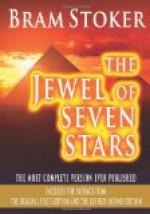“‘One thing at a time!’ he said quietly. ’Your first question contains all the rest. Where are these lamps? I shall tell you: In the tomb!’
“‘In the tomb!’ I repeated in surprise. ’Why you and I searched the place ourselves from end to end; and there was not a sign of a lamp. Not a sign of anything remaining when we came away the first time; or on the second, except the bodies of the Arabs.’
“Whilst I was speaking, he had uncoiled some large sheets of paper which he had brought in his hand from his own room. These he spread out on the great table, keeping their edges down with books and weights. I knew them at a glance; they were the careful copies which he had made of our first transcripts from the writing in the tomb. When he had all ready, he turned to me and said slowly:
“’Do you remember wondering, when we examined the tomb, at the lack of one thing which is usually found in such a tomb?’
“‘Yes! There was no serdab.’
“The serdab, I may perhaps explain,” said Mr. Corbeck to me, “is a sort of niche built or hewn in the wall of a tomb. Those which have as yet been examined bear no inscriptions, and contain only effigies of the dead for whom the tomb was made.” Then he went on with his narrative:
“Trelawny, when he saw that I had caught his meaning, went on speaking with something of his old enthusiasm:
“’I have come to the conclusion that there must be a serdab—a secret one. We were dull not to have thought of it before. We might have known that the maker of such a tomb—a woman, who had shown in other ways such a sense of beauty and completeness, and who had finished every detail with a feminine richness of elaboration—would not have neglected such an architectural feature. Even if it had not its own special significance in ritual, she would have had it as an adornment. Others had had it, and she liked her own work to be complete. Depend upon it, there was—there is—a serdab; and that in it, when it is discovered, we shall find the lamps. Of course, had we known then what we now know or at all events surmise, that there were lamps, we might have suspected some hidden spot, some cachet. I am going to ask you to go out to Egypt again; to seek the tomb; to find the serdab; and to bring back the lamps!’”
“’And if I find there is no serdab; or if discovering it I find no lamps in it, what then?’ He smiled grimly with that saturnine smile of his, so rarely seen for years past, as he spoke slowly:
“‘Then you will have to hustle till you find them!’
“‘Good!’ I said. He pointed to one of the sheets.
“’Here are the transcripts from the Chapel at the south and the east. I have been looking over the writings again; and I find that in seven places round this corner are the symbols of the constellation which we call the Plough, which Queen Tera held to rule her birth and her destiny. I have examined them carefully, and I notice that they are all representations of the grouping of the stars, as the constellation appears in different parts of the heavens. They are all astronomically correct; and as in the real sky the Pointers indicate the Pole Star, so these all point to one spot in the wall where usually the serdab is to be found!’




